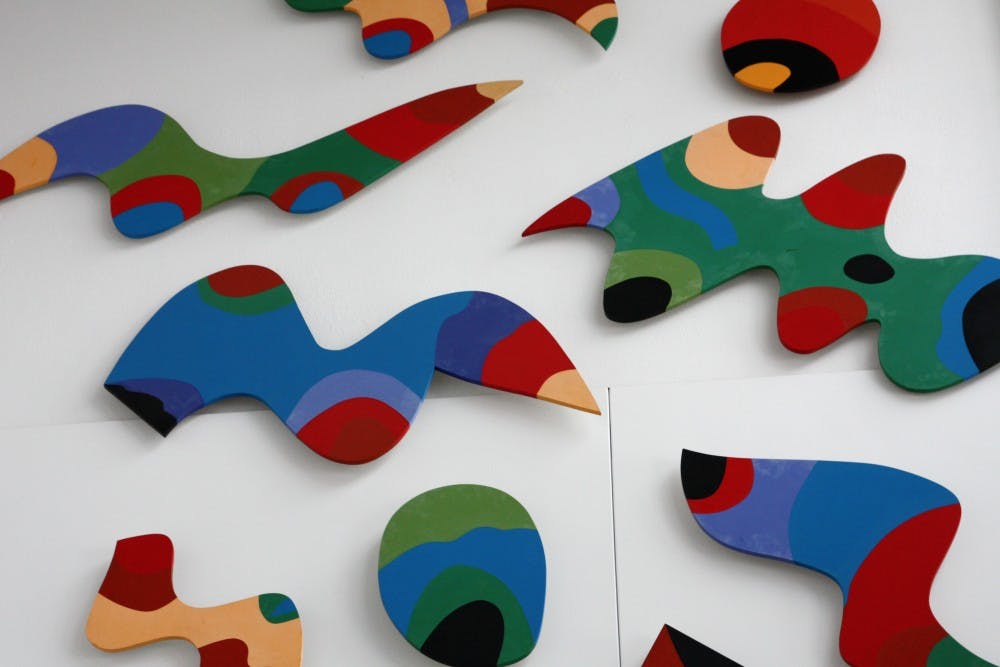Tucked between the Annenberg Center for the Performing Arts and Charles Addams Fine Arts Hall is the Annenberg School for Communication, one of the more heavily traversed spots on campus. While most of Penn students have been inside, few notice the multihued, 17–component mural spanning the east wall of the school’s lobby. It’s Sam Maitin’s (C '51) "Celebration."
Commissioned by Walter and Leonore Annenberg for the school in 1975, the mural is, at first glance, mere colorful shapes. One looks like a raindrop. Another, a saxophone. Above, a squirming worm. Together, they seem like pieces of a jigsaw puzzle that don’t quite seem to fit. Against the white wall, the fire–engine reds, vivid greens, and vibrant purples demand attention, drawing the eye to its simple, almost childlike manner. “I try to nurture the child in me—the innocence, the curiosity, the originality, the exultant primitivism,” Maitin told the Gazette in 1987. “I wanted the color to be in three dimensions.” The beauty behind Celebration is precisely this primitivism. It’s not a piece attempting to imitate or copy anything nor is it trying to capture something real. The colors, shapes, and forms are not a means to portray something else, but are the end in themselves.

His pure and whimsical nature is also communicated through the unusual shapes of each of the 17 pieces and the seemingly arbitrary subdivision of the shapes into different colors. “The real business of art to me is to play with form, shape, and color,” he said in a 1999 interview. For him, art was “this joy of just putting color, texture, and shape together in an experimental way.” The bright colors and playful forms convey this happiness and joy Maitin felt at the time of its creation. Appearing on this year’s holiday card from the dean of Annenberg, it’s described as an “ongoing celebration of the friendship, vision, and spirit for the entire Annenberg community.”
But what makes this piece specifically relevant to Penn, as opposed to all the other murals and paintings in Penn’s art collection, is the artist itself. A Philadelphia native, Maitin was a Penn alum, having graduated with a Bachelor of Fine Arts. His time at Penn began as a moonlighting experience as a night student in 1945 when he was just 16. At the time, he was attending the Philadelphia Museum School of Industrial Arts (now the University of the Arts). Upon graduation, he quickly established himself as an internationally renowned artist, his works reaching big names such as the Philadelphia Museum of Art, the Museum of Modern Art in New York, the Smithsonian Institution in Washington, and the Tate Gallery in London.

In between his time as an artist, Maitin also taught at Annenberg from 1965 to 1972, serving as the head of the Visual Graphics Communication Laboratory. Besides Celebration in his home school, he has also contributed artworks to the School of Arts and Sciences, the Wharton School, and the Dental School, and the Christian Association on campus over the years. His versatility also showed in the range of mediums he worked in. He specialized in silkscreen prints, paintings, and sculptures, but is best known for his public art. Between posters for bus–shelters, murals for the Children’s Hospital of Philadelphia, and paintings for the Christian Association, all of it is meant to be accessible. “What I hate is this whole elitist concept of art, that it’s something precious and ethereal, when art is actually part of life,” he told the Gazette in the same 1987 interview.
Next time you rush through the lobby to the lecture halls of Annenberg, take five seconds to absorb the colors and shapes of "Celebration." What can seem so simple at first glance may actually hold an entirely new way of seeing.

